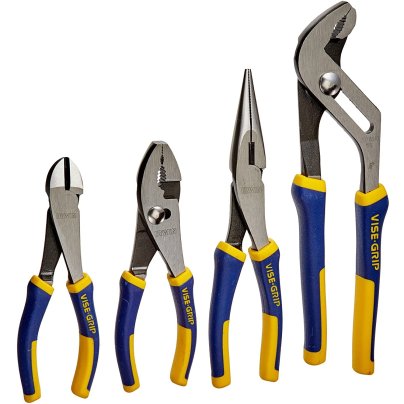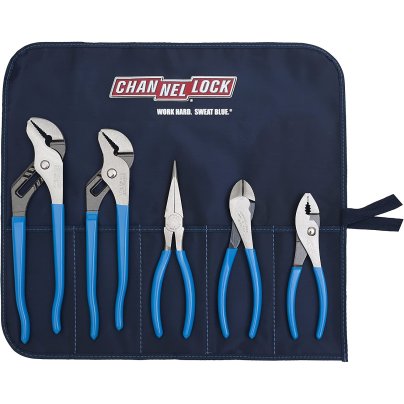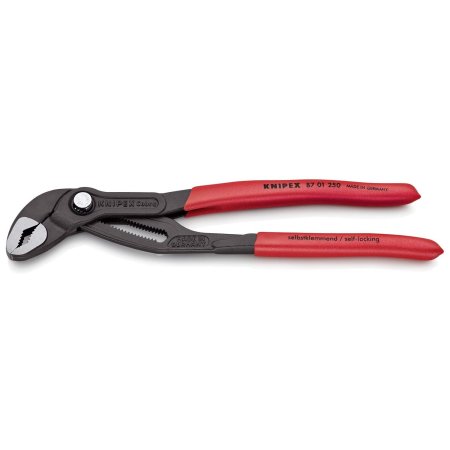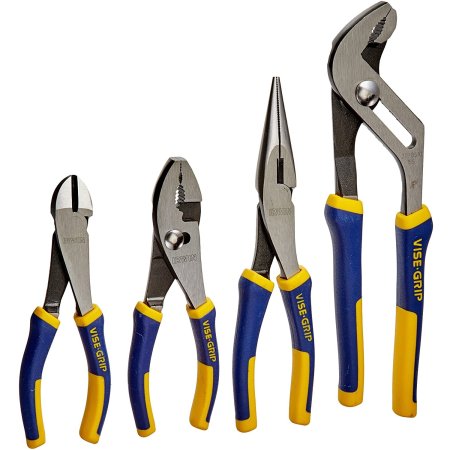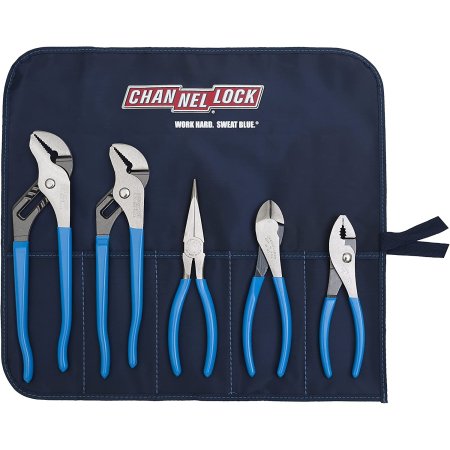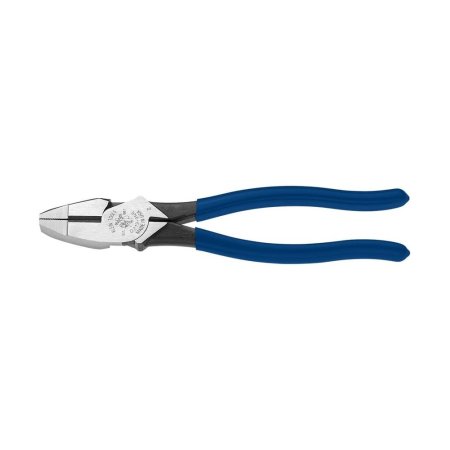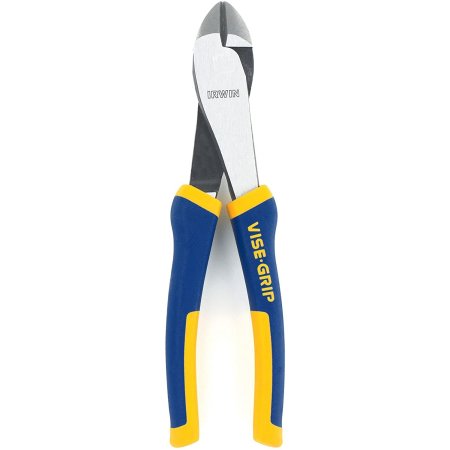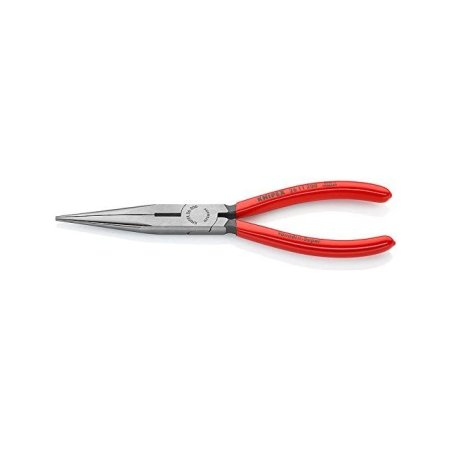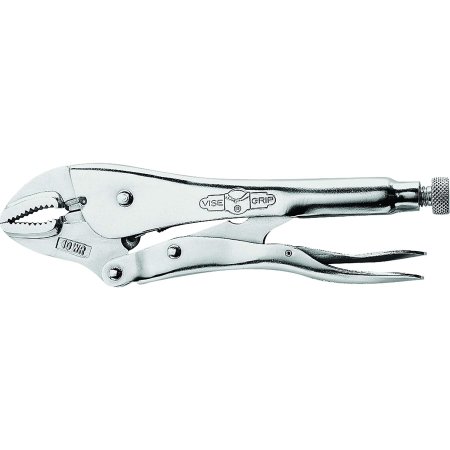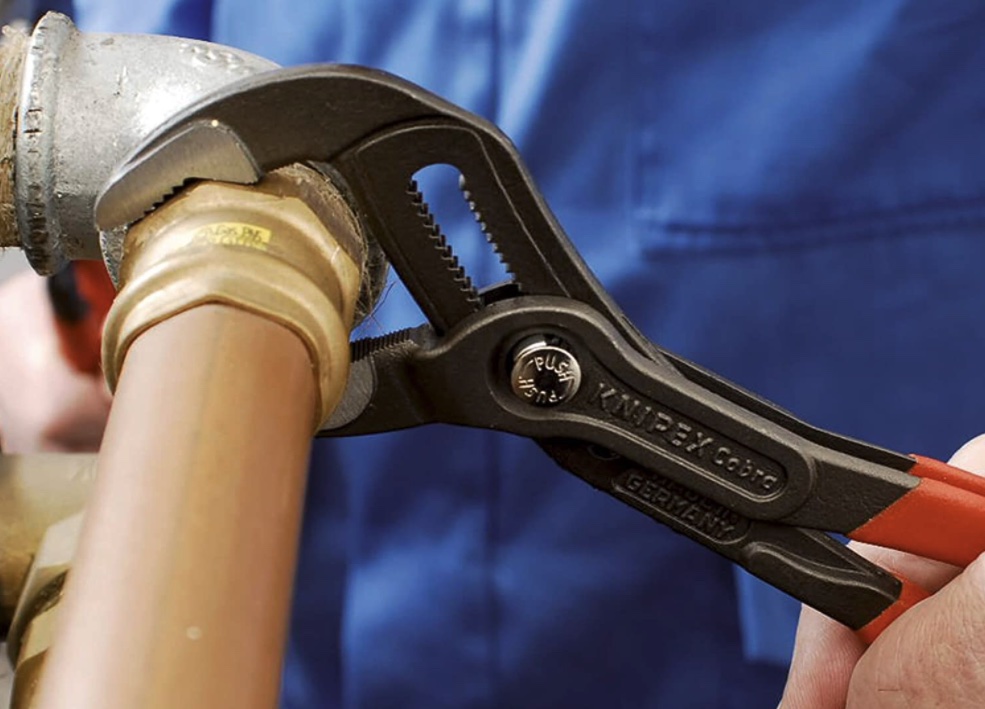
We may earn revenue from the products available on this page and participate in affiliate programs. Learn More ›
Picking the best pliers is an important decision, whether you’re a new homeowner, an apartment dweller, or an old-school DIYer. These grip-magnifying tools grab hold of an object that needs removing, tightening, pulling, or cutting. But there’s a problem: Different types of pliers can often make choosing the best one difficult.
Whether it’s tightening metal pipes, wiring an outlet, or trying to keep a grip on a tiny fastener, there’s a plier that’s best suited for the job. The guide to pliers below will help, as it crowns some of the best pliers in each style to complete a well-stocked tool box.
- BEST OVERALL: KNIPEX Tools – Cobra Water Pump Pliers
- BEST BUDGET: Irwin Vice-Grip Pliers Set, 4-Piece
- UPGRADE PICK: Channellock TOOL ROLL-3 5 Piece Pliers Set
- BEST FOR GENERAL USE: Channellock 526 6-Inch Slip Joint Pliers
- BEST FOR ELECTRICAL WORK: Klein Tools 9-Inch High Leverage Pliers
- BEST FOR CUTTING WIRE: Irwin Vice-Grip Diagonal Cutting Pliers
- BEST FOR SMALL SPACES: KNIPEX Tools Long Nose Pliers with Cutter
- BEST FOR LOCKING ON: Irwin Vice-Grip Original Locking Pliers with Wire Cutter
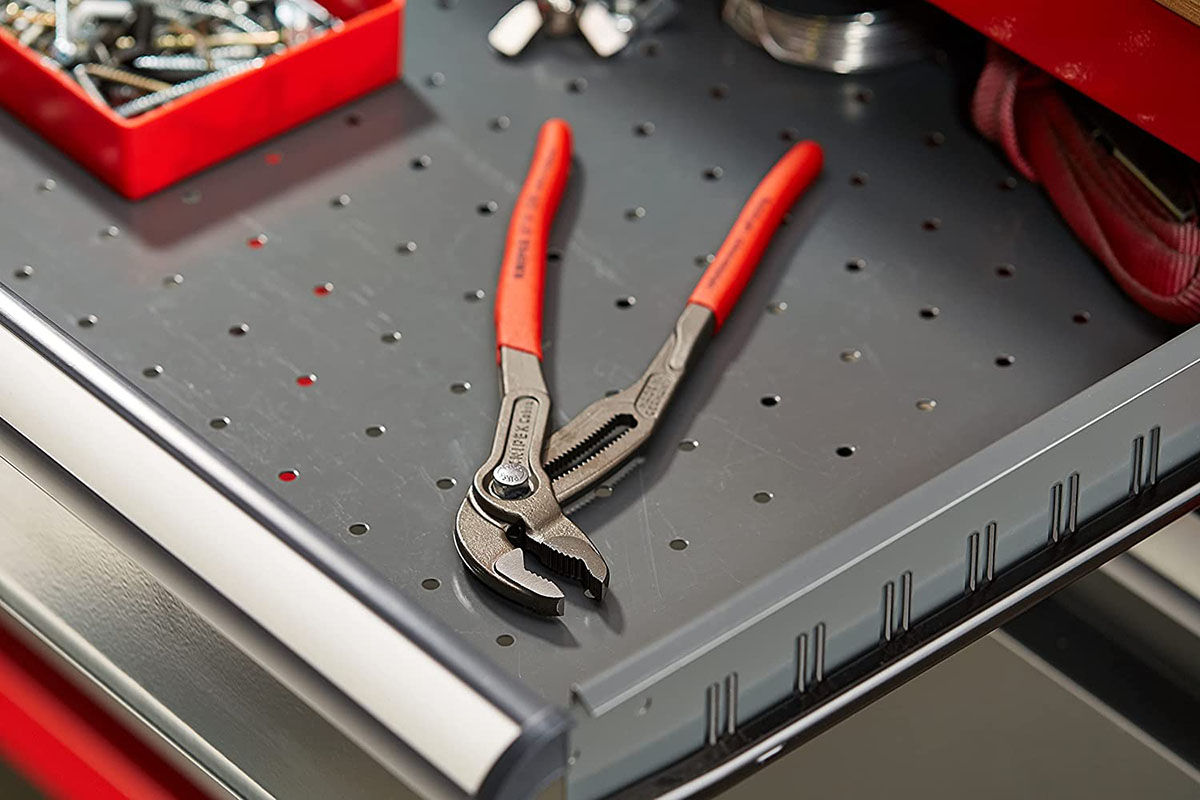
Common Types of Pliers
When choosing the best pliers, be sure to understand that there are several types, each with its own strengths and weaknesses. Most tool kits can benefit from at least one pair of each.
Slip-Joint Pliers
The slip-joint is the most common type of pliers, with a sliding fulcrum that allows the user to adjust the tool’s jaw size and width. Usually, these pliers have two sets of teeth: one in the shape of an arc for gripping round objects, and another arranged on a flat surface for pinching.
Slip-joint pliers are fine for low-torque situations, such as removing a nut from furniture hardware or twisting a valve shut. However, they’re likely to strip a nut or bolt if the fastener is stubborn.
Needle-Nose Pliers
When it comes to reaching into tight places or gripping small objects, the needle-nose plier reigns supreme. These pliers have long, thin noses that can reach into small spaces like computer towers, electrical terminals, or plumbing-valve bodies. They can then grab small pieces or wires that would otherwise be inaccessible.
Needle-nose pliers are excellent for assembling small objects or electronics, as well as general electrical work. Their ability to grab tiny objects while allowing the user to see what they’re doing (rather than blocking the view with their hands) makes otherwise-difficult work much easier.
Tongue-and-Groove Pliers
Tongue-and-groove pliers are favorites among mechanics, maintenance technicians, plumbers, and HVAC techs. These pliers have several grooves that adjust the width of the jaws, allowing one set of pliers to grip a variety of fasteners and pipes. Also, their jaw-forward design and long handles allow the user to apply a lot of pressure on the fastener, pipe, or other objects.
Tongue-and-groove pliers are also known as “water-pump pliers” or “channel locks.” Channellock is a brand name, and it’s this kind of plier that has made the Channellock brand so popular.
Locking Pliers
As the name suggests, locking pliers have mechanisms that snap and lock onto an object. Often, these pliers have knobs on their handles that the user can turn to adjust the jaw width. Once the pliers are set properly, the user can squeeze the jaws onto a fastener, pipe, or other objects. The mechanism in the handle then locks, holding the jaws closed until the user removes them.
The best locking pliers are useful for a variety of projects, from plumbing to vehicle or bicycle repair. They’re also commonly referred to as vise grips, though “Vise-Grip” is a brand name.
Linesman’s Pliers
Linesman’s pliers are the electrician’s pliers of choice. These pliers feature heavy-duty jaws with cutting edges and serrated teeth. Some models even include wire strippers. The cutting edges allow the user to cut wire to length while also allowing them to remove a wire jacket with a developed technique.
Also, electricians often use their linesman’s pliers as makeshift hammers. They can use them to punch through knockout on electrical boxes, drive staples, and other tasks.
Cutting Pliers
Cutting pliers have one job: to cut things apart. These pliers feature short cutting edges and long handles for applying force. Many have diagonal blades (known as diagonal cutters), while others might have cutting edges on their ends (end-cutting pliers).
These tools are excellent for cutting wire, nipping the ends off nails, opening strapped packages, and other practical cutting needs.
What to Consider When Choosing the Best Pliers
It’s important to know more than just the type of pliers before tossing a pair into the shopping cart. Keep the following considerations in mind when comparing models in order to make the right choice for the job.
Size
Many pliers, depending on the type, come in different sizes. Smaller sizes are excellent for storing in a back pocket or tool box, while other, larger pliers might be necessary for obtaining enough leverage to get the job done.
Generally speaking, pliers in the 8- to 12-inch range are the most useful. Smaller pliers (under 8 inches) are good for delicate work, but they lack the grip and jaw capacity for a heavy-duty project. Large pliers are great for heavy-duty work, but they can easily damage light-duty materials. Whenever possible, a tool box should contain sets of pliers in each size.
Adjustable vs. Nonadjustable
Different job requirements call for different pliers: adjustable or nonadjustable. Adjustable pliers allow the user to tailor the jaw size to the task at hand, which is good for gripping and turning objects. For instance, some pliers might be able to adjust up to 3 or 4 inches, so they can grip small objects as well as large pipes.
However, when it comes to cutting, adjustability is not a benefit. In these cases, it’s necessary to get something that will work for years and years, with tighter tolerances and less sloppiness than those required for adjustable pliers.
Head and Handle Material
The best pliers come in just a few materials. While “tool steel” is generally acceptable, today’s best pliers have more to offer than a rust-prone metal that will become hard to use. The most popular metal options today are alloys, which are combinations of metals. Vanadium, chromium, and nickel-chrome steel are tough, strong, and rust-resistant, and they’re typically the most common.
Handles are equally as important. Many pliers feature coated handles for grip as well as fatigue reduction. These grips are typically rubber, vinyl, polyurethane, or a combination of materials. They offer grip and shock absorption, making them ideal for heavy-duty work.
Comfort and Ease of Use
The job at hand will determine which models are the most comfortable and easiest to use. Tongue-and-groove or pump pliers are almost always the most comfortable to use for turning pipes or fasteners. And with several jaw adjustments available from one set of pliers, the user needn’t carry a large set of wrenches or several sets of pliers.
However, keep in mind that specialty pliers are designed for certain tasks. When it comes to cutting wires, linesman’s pliers tend to have the leverage necessary to accomplish the job with comfort and ease. When reaching into tight places, the needle-nose plier will almost always work best. For that reason, it’s best to have several types of pliers at the ready.
Versatility
Specialty pliers are great, but many pliers provide the value of versatility. For instance, pump pliers excel at just about everything (other than dealing with small parts). Likewise, a pair of linesman’s pliers can cut, twist, and hammer, making them more versatile than a pair of needle-nose pliers. Conversely, cutting pliers might be great at slicing things apart, but they’re near useless for gripping fasteners.
For general use, pump pliers are the most versatile. However, if they’re for specific purposes, it’s best to get the tool designed for that job.
Our Top Picks
“Get the right tool for the job.” That well-known saying is never more applicable than when it comes to choosing the best pliers for a project. Certain types of pliers can work wonders for some jobs but fail miserably at others. This guide examines some of the best pliers in each style and describes the tasks for which they are best suited.
Best Overall
KNIPEX Tools – Cobra Water Pump Pliers
Pros
- Push-button adjustment
- Adjusts while on the workpiece
- Durable, oil-hardened chrome-vanadium construction
Cons
- Can create too much leverage
When it comes to finding a do-all style of pliers, there’s no beating a set of groove-joint (or water-pump) pliers. These Knipex 10-inch tools are not only a great size, but they’re also of top-notch quality. They’re at the top of the game when it comes to material, grip, and convenience.
Common pump pliers need to open completely to adjust. Knipex pliers, on the other hand, use push-button adjustments. This allows the user to adjust the grip while the plier is on the workpiece, without opening the jaws.
These forged chrome-vanadium and oil-hardened pliers are incredibly durable. The jaws will provide a solid grip against both the hardest and smoothest materials. They switch easily from nuts and bolts to pipes thanks to the push-button adjustment. Just be aware that these pliers create a lot of leverage and might mar a workpiece if used carelessly.
Product Specs
- Type: Tongue-and-groove
- Size: 10 inches
- Material: Chrome-vanadium body with rubber grips
Best Budget
Irwin Vice-Grip Pliers Set, 4-Piece
Pros
- Variety of styles in one kit
- Precision joints reduce wobble and sloppiness
- Comfortable nonslip grips
Cons
- Tongue-and-groove pliers can be a little bulky
For anyone looking for a quick boost for a tool box, this set of Vise-Grip pliers from Irwin will do the trick—and it can also save some cash. It includes diagonal cutters, slip-joint pliers, needle-nose pliers, and a set of adjustable groove-joint pliers. Each of these has comfortable nonslip grips, a design that reduces discomfort and pinching when the user has to apply a lot of leverage.
They’re all constructed from nickel-chromium steel, so they’ll be strong and long-lasting. Irwin also reduces the wobble and play found in most adjustable pliers with precision joints that make them a pleasure to use. They also come with a tool wrap to roll them up and store away in a drawer or at the bottom of a tool box, which is a plus, since the tongue-and-groove pliers can be a little bulky (thanks to the thick handles).
Product Specs
- Type: Tongue-and-groove, needle-nose, slip-joint, and diagonal cutters
- Size: 10-inch to 6-inch
- Material: Nickel-chromium steel
Upgrade Pick
Channellock TOOL ROLL-3 5 Piece Pliers Set
Pros
- Comes with 2 sets of pump pliers
- All-in-one kit
- High-quality tool roll
Cons
- No chromium or vanadium used in construction
Channellock is so well-known that the industry refers to all groove-joint pliers as “Channellocks.” This set of five pliers includes slip-joint pliers, diagonal cutters, needle-nose pliers, and two sets of groove-joint pump pliers. The double set of groove-joints is important for plumbing applications.
The variety of tools in this set gives most users everything they need in the plier world. The vinyl-dipped grips keep hands comfortable, while the high-carbon steel is long lasting and durable. The only thing to beware of is, without chromium or vanadium, these pliers might age faster than some others.
Product Specs
- Type: Variety
- Size: 10-inch to 6-inch
- Material: High-carbon steel
Best for General Use
Channellock 526 6-Inch Slip Joint Pliers
Pros
- PermaLock fasteners for a tight, long-lasting action
- Nonslip vinyl grips
- Built-in wire cutters
Cons
- Limited to basic, low-torque tasks
This set of slip-joint pliers from Channellock is useful for almost any gripping task around the house, and their small size makes them easy to stow away in a drawer. The 6-inch slip-joint pliers use the company’s patented PermaLock fasteners, which replace the nut and bolt that hold most low-end pliers together.
The result is a tight set of slip-joint pliers with a reliable and predictable action that reduces failures, injuries, and the stripping of nuts and bolts. The nonslip vinyl grips make these pliers easy to hold on to but comfortable enough for prolonged use. The included shear-type wire cutter is also a nice feature, making these tools perfect for cutting strips of wire and cord—something most other slip-joints don’t offer. But, like other slip-joint pliers, these are limited to simple tasks based on their design.
Product Specs
- Type: Slip-joint
- Size: 6 inches
- Material: High-carbon steel
Best for Electrical Work
Klein Tools 9-Inch High Leverage Pliers
Pros
- Rivet-forward design increases leverage
- Shock-absorbing handles
- Alloy steel with induction-hardened cutting edges
Cons
- Heavy
For DIYers in the middle of a renovation or those who do their fair share of electrical work, these linesman-style pliers from Klein Tools are the definition of dependable. They also have some great features, including a hot-riveted joint for smooth opening and closing, knurled jaws for gripping wires and fasteners, and induction-hardened cutting knives for slicing through tough cables with ease, and scoring and stripping wire coating.
Klein designed these tools to increase leverage by moving the riveted joint closer to the cutting teeth, so even users without a lot of grip strength can cut heavy-gauge wires. One of the best features is the handle tempering that absorbs shock, an excellent feature for those making repetitive cuts. Just understand that as a heavy-duty set of pro-grade pliers, they are a little heavy at around 1 pound.
Product Specs
- Type: Linesman’s pliers
- Size: 9 inches
- Material: Alloy steel
Best for Cutting Wire
Irwin Vice-Grip Diagonal Cutting Pliers
Pros
- Heavy-duty steel with induction-hardened teeth
- Thick, shock-absorbing grips
- Long handles for plenty of leverage
Cons
- Won’t grab fasteners (no cutters will)
Diagonal cutters are very purpose-specific: Their only job is to cut things. And when a tool has only one job, it had better do it well. The Irwin Vise-Grip Diagonal Cutters can make short work of long wires and cables. Their nickel-chromium steel construction makes them tough and durable, while the cutting edges are induction hardened.
With these hardened cutting edges, they’ll stay sharp for plenty of typical DIY projects (whether cutting electrical wires or pulling a nail shot from a nail gun). And for extremely tough materials, the over-molded and rubberized grips are nonslip and comfortable, reducing muscle and joint fatigue. They’re also long enough to give the user plenty of leverage. Keep in mind, though, that these pliers aren’t for fasteners like nuts and bolts, as they have very little surface area for gripping.
Product Specs
- Type: Diagonal cutters
- Size: 8 inches
- Material: Chromium steel
Best for Small Spaces
KNIPEX Tools Long Nose Pliers with Cutter
Pros
- Long, slender jaws with plenty of grip
- Built-in cutters
- Half-round nose for bending perfect wire hooks
Cons
- Needle nose design does limit grip
There are plenty of scenarios where a good set of needle-nose pliers is the only tool for the job. When repairing electronics, automotive wiring, or even a child’s trampoline, needle-nose pliers are the way to go. They can reach into tight spots, increase leverage, and even coerce springs into place.
This set of long nose pliers from Knipex is a high-quality choice for both DIYers and pros. It utilizes the same chrome-vanadium steel as the other tools in the Knipex lineup, with the company’s oil-hardened finish for longevity. The built-in cutting edges will cut and strip wire without issue, while the half-rounded jaws make bending wire ends into perfect hooks an easy task. With all those features, these pliers are an excellent tool for wiring projects and low-clearance situations. However, understand that they won’t offer quite the grip of a standard set of pliers.
Product Specs
- Type: Needle-nose
- Size: 8 inches
- Material: Chrome vanadium
Best for Locking On
Irwin Vice-Grip Original Locking Pliers with Wire Cut
Pros
- Fine-tuned clamping
- Made from high-grade, heat-treated steel
- Rounded-jaw design
Cons
- Heavy
Irwin Vise-Grip’s Original Locking Pliers, with a knurled adjustment knob and trigger release for easy on and off, are suitable for DIY mechanics, cycling enthusiasts, and all-around handy types, as they provide a firm grip with lots of leverage. The knurled adjustment knob has a hex-key fitting for fine-tuning the pliers’ grip when it’s already clamped in place.
These locking pliers allow the user’s hand to focus on dexterity instead of squeezing to remove stubborn fasteners. For many projects, they can lock on to a fastener or fitting and stay in place, freeing both hands for other aspects of the project. They also feature a curved-jaw design for round items. They’re made of high-grade, heat-treated steel, so they should last a while. Just keep in mind that this set is large and heavy, so it may be too big for a tool belt.
Product Specs
- Type: Locking
- Size: 10 inches
- Material: Alloy steel
Our Verdict
For anyone in need of an all-around great set of pliers, it’s hard to beat the versatility and design of the KNIPEX Tools Cobra Water Pump Pliers. But if the job calls for variety, the Channellock TOOL ROLL-3 5 Piece Pliers Set brings multiple options to the table.
How We Chose the Best Pliers
When it comes to putting together a list of tools as important as pliers, a lot of time, product research, and personal experience are required. We compared many products and narrowed the list down to only the best.
First, we compared materials and price, ensuring that we were recommending pliers that offered a steel worthy of their price tag. Next, we compared functionality and type to be sure we offered something for every scenario. Finally, we drew on firsthand experience with all of these tools for their respective category award.
Between these comparisons and experience, we were able to put together a list of the best pliers on the market to make shopping for these tools a little easier.
FAQs
That might seem like a lot of information on the best pliers, but don’t let your head spin around like a fastener on a bolt. We put together the following list of the most common questions about pliers, so be sure to check for an answer to your question listed below.
Q: What are pliers used for?
Pliers serve a variety of purposes, such as assembling and disassembling pipes, securing and loosening fasteners, grabbing small items, and more.
Q: Can you cut with pliers?
Many pliers come with built-in cutters to slice through wire, thin metal, and other small objects.
Q: What is the difference between a wrench and pliers?
A wrench is designed to fit a fastener, and the user is unable to squeeze the jaws at will. A pair of pliers benefits from squeezing the handles to increase their strength, and they’re suitable for a variety of jobs.
Q: What are the most commonly used pliers?
The most commonly used pliers are slip-joints; however, water-pump or tongue-and-groove pliers are often the most useful.
Q: How are plier sizes measured?
Plier sizes are measured from the handle to the jaws, and they’re not overly accurate. For example, a 6-inch set of pliers could actually measure 6½ inches.
Q: How should I maintain pliers?
Maintaining pliers is easy. First, be sure to clean the serrations or teeth when they become gunked up. Then, a quick spray of lubricant at the pivot point will keep them working smoothly.

